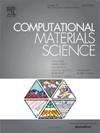交换相关泛函在磁性描述中的缺陷:铁氢合金的警示故事
IF 3.1
3区 材料科学
Q2 MATERIALS SCIENCE, MULTIDISCIPLINARY
引用次数: 0
摘要
FeRh的磁基态对晶格常数高度敏感。除了部分填充的Fe和Rh的d壳层外,这对过去的密度泛函理论(DFT)计算提出了重大挑战。在这里,我们研究了这种具有挑战性的二元合金在DFT形式化中的各种交换相关(XC)泛函的性能。我们使用了局部密度近似(LDA),各种广义梯度近似(GGAs),以及新开发的强约束和适当赋范(SCAN)元gga泛函。我们的结果表明,在捕获FeRh中结构、电子和磁性的复杂相互作用时,任何单一功能的局限性。虽然SCAN可以准确地描述某些磁特征和声子色散,但它明显高估了Fe-Fe磁相互作用,导致磁有序温度不合理。相反,Perdew-Burke-Ernzerhof (PBE) GGA表现出相反的行为。这些发现突出了使用DFT模拟部分填充d壳层材料的挑战,强调了开发多功能XC函数的关键需求,该函数可以有效地解释此类系统的多面性。本文章由计算机程序翻译,如有差异,请以英文原文为准。
Pitfalls of exchange–correlation functionals in description of magnetism: Cautionary tale of the FeRh alloy
The magnetic ground state of FeRh is highly sensitive towards the lattice constant. This, in addition to partially filled -shells of Fe and Rh, posed a significant challenge for Density Functional Theory (DFT) calculations in the past. Here, we have investigated the performance of various exchange–correlation (XC) functionals within the DFT formalism for this challenging binary alloy. We have employed Local Density Approximation (LDA), various Generalized Gradient Approximations (GGAs), and newly developed Strongly Constrained and Appropriately Normed (SCAN) meta-GGA functional. Our results show the limitations of any single functional in capturing the intricate interplay of structural, electronic, and magnetic properties in FeRh. While SCAN can accurately describe some magnetic features and phonon dispersion, it significantly overestimates the Fe-Fe magnetic interactions, leading to an unreasonable magnetic ordering temperature. Conversely, the Perdew–Burke–Ernzerhof (PBE) GGA exhibits the opposite behavior. These findings highlight the challenges in simulating materials with partially filled -shells using DFT, underscoring the crucial need for developing a versatile XC functional that can effectively account for the multifaceted nature of such systems.
求助全文
通过发布文献求助,成功后即可免费获取论文全文。
去求助
来源期刊

Computational Materials Science
工程技术-材料科学:综合
CiteScore
6.50
自引率
6.10%
发文量
665
审稿时长
26 days
期刊介绍:
The goal of Computational Materials Science is to report on results that provide new or unique insights into, or significantly expand our understanding of, the properties of materials or phenomena associated with their design, synthesis, processing, characterization, and utilization. To be relevant to the journal, the results should be applied or applicable to specific material systems that are discussed within the submission.
 求助内容:
求助内容: 应助结果提醒方式:
应助结果提醒方式:


